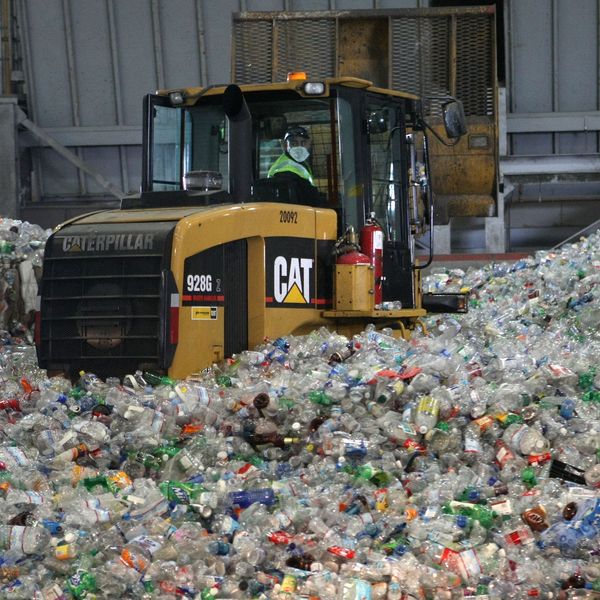Study: Over 100 Million Americans Drinking 'Toxic Trash' Water
New analysis from Environmental Working Group shows carcinogenic chemical lurking in nation's public water
When you pour yourself a glass of tap water or even take a shower, you may be among over 100 million Americans exposing yourself to carcinogenic, "toxic trash."
Watchdog organization Environmental Working Group (EWG) looked at 2011 water quality tests for over 200 municipal water systems that affect 100 million people in 43 states.
In their analysis published Wednesday, the group documents that all the systems had water polluted with chemicals called trihalomethanes--chemicals caused when chlorine, used as a disinfectant, mingles with rotting organic matter such as farm runoff or sewage.
While the EPA refers to these trihalomethanes as "disinfection byproducts," EWG says they are "toxic trash."
Trihalomethanes have been linked to a range of health problems including bladder cancer, colon and rectal cancer, birth defects, low birth weight and miscarriage.
While only the municipal water system of Davenport, Iowa showed levels that exceeded the upper legal limit the EPA established in 1998 of 80 parts per billion of trihalomethanes in drinking water, EWG points to multiple studies showing an increased risk of bladder cancer caused by much lower levels of trihalomethanes.
"New science makes a compelling case for stronger regulations and a stricter legal limit," said Renee Sharp, a senior scientist at EWG and co-author of the analysis.
Further, EWG's analysis notes that the levels of this "toxic trash" recorded are for annual averages, but there are likely contamination spikes, something of particular danger for pregnant women.
"Many people are likely exposed to far higher concentrations of trihalomethanes than anyone really knows," stated Sharp. "For most water systems, trihalomethane contamination fluctuates from month to month, sometimes rising well beyond the legal limit set by the federal Environmental Protection Agency."
The problem with trihalomethanes arises because water treatment facilities are forced to deal with contaminants to begin with, so EWG says improvements, which are ultimately less costly, must be made to have cleaner source water.
Among EWG's recommendations:
- Congress should reform farm policies to provide more funds to programs designed to keep agricultural pollutants such as manure, fertilizer, pesticides and soil out of tap water.
- Congress should renew the "conservation compliance" provisions of the 1985 farm bill by tying wetland and soil protection requirements to crop insurance programs, by requiring farm businesses that receive subsidies to update their conservation plans and by strengthening the government's enforcement tools.
- Congress must allocate significant money to help repair and upgrade the nation's water infrastructure.
- Source water protection programs should be significantly expanded, including efforts to prevent or reduce pollution of source waters and to conserve land in buffer zones around public water supplies. Financial support for these projects is crucial.
Read the full report here (pdf).
___________________________________
An Urgent Message From Our Co-Founder
Dear Common Dreams reader, The U.S. is on a fast track to authoritarianism like nothing I've ever seen. Meanwhile, corporate news outlets are utterly capitulating to Trump, twisting their coverage to avoid drawing his ire while lining up to stuff cash in his pockets. That's why I believe that Common Dreams is doing the best and most consequential reporting that we've ever done. Our small but mighty team is a progressive reporting powerhouse, covering the news every day that the corporate media never will. Our mission has always been simple: To inform. To inspire. And to ignite change for the common good. Now here's the key piece that I want all our readers to understand: None of this would be possible without your financial support. That's not just some fundraising cliche. It's the absolute and literal truth. We don't accept corporate advertising and never will. We don't have a paywall because we don't think people should be blocked from critical news based on their ability to pay. Everything we do is funded by the donations of readers like you. Will you donate now to help power the nonprofit, independent reporting of Common Dreams? Thank you for being a vital member of our community. Together, we can keep independent journalism alive when it’s needed most. - Craig Brown, Co-founder |
When you pour yourself a glass of tap water or even take a shower, you may be among over 100 million Americans exposing yourself to carcinogenic, "toxic trash."
Watchdog organization Environmental Working Group (EWG) looked at 2011 water quality tests for over 200 municipal water systems that affect 100 million people in 43 states.
In their analysis published Wednesday, the group documents that all the systems had water polluted with chemicals called trihalomethanes--chemicals caused when chlorine, used as a disinfectant, mingles with rotting organic matter such as farm runoff or sewage.
While the EPA refers to these trihalomethanes as "disinfection byproducts," EWG says they are "toxic trash."
Trihalomethanes have been linked to a range of health problems including bladder cancer, colon and rectal cancer, birth defects, low birth weight and miscarriage.
While only the municipal water system of Davenport, Iowa showed levels that exceeded the upper legal limit the EPA established in 1998 of 80 parts per billion of trihalomethanes in drinking water, EWG points to multiple studies showing an increased risk of bladder cancer caused by much lower levels of trihalomethanes.
"New science makes a compelling case for stronger regulations and a stricter legal limit," said Renee Sharp, a senior scientist at EWG and co-author of the analysis.
Further, EWG's analysis notes that the levels of this "toxic trash" recorded are for annual averages, but there are likely contamination spikes, something of particular danger for pregnant women.
"Many people are likely exposed to far higher concentrations of trihalomethanes than anyone really knows," stated Sharp. "For most water systems, trihalomethane contamination fluctuates from month to month, sometimes rising well beyond the legal limit set by the federal Environmental Protection Agency."
The problem with trihalomethanes arises because water treatment facilities are forced to deal with contaminants to begin with, so EWG says improvements, which are ultimately less costly, must be made to have cleaner source water.
Among EWG's recommendations:
- Congress should reform farm policies to provide more funds to programs designed to keep agricultural pollutants such as manure, fertilizer, pesticides and soil out of tap water.
- Congress should renew the "conservation compliance" provisions of the 1985 farm bill by tying wetland and soil protection requirements to crop insurance programs, by requiring farm businesses that receive subsidies to update their conservation plans and by strengthening the government's enforcement tools.
- Congress must allocate significant money to help repair and upgrade the nation's water infrastructure.
- Source water protection programs should be significantly expanded, including efforts to prevent or reduce pollution of source waters and to conserve land in buffer zones around public water supplies. Financial support for these projects is crucial.
Read the full report here (pdf).
___________________________________
When you pour yourself a glass of tap water or even take a shower, you may be among over 100 million Americans exposing yourself to carcinogenic, "toxic trash."
Watchdog organization Environmental Working Group (EWG) looked at 2011 water quality tests for over 200 municipal water systems that affect 100 million people in 43 states.
In their analysis published Wednesday, the group documents that all the systems had water polluted with chemicals called trihalomethanes--chemicals caused when chlorine, used as a disinfectant, mingles with rotting organic matter such as farm runoff or sewage.
While the EPA refers to these trihalomethanes as "disinfection byproducts," EWG says they are "toxic trash."
Trihalomethanes have been linked to a range of health problems including bladder cancer, colon and rectal cancer, birth defects, low birth weight and miscarriage.
While only the municipal water system of Davenport, Iowa showed levels that exceeded the upper legal limit the EPA established in 1998 of 80 parts per billion of trihalomethanes in drinking water, EWG points to multiple studies showing an increased risk of bladder cancer caused by much lower levels of trihalomethanes.
"New science makes a compelling case for stronger regulations and a stricter legal limit," said Renee Sharp, a senior scientist at EWG and co-author of the analysis.
Further, EWG's analysis notes that the levels of this "toxic trash" recorded are for annual averages, but there are likely contamination spikes, something of particular danger for pregnant women.
"Many people are likely exposed to far higher concentrations of trihalomethanes than anyone really knows," stated Sharp. "For most water systems, trihalomethane contamination fluctuates from month to month, sometimes rising well beyond the legal limit set by the federal Environmental Protection Agency."
The problem with trihalomethanes arises because water treatment facilities are forced to deal with contaminants to begin with, so EWG says improvements, which are ultimately less costly, must be made to have cleaner source water.
Among EWG's recommendations:
- Congress should reform farm policies to provide more funds to programs designed to keep agricultural pollutants such as manure, fertilizer, pesticides and soil out of tap water.
- Congress should renew the "conservation compliance" provisions of the 1985 farm bill by tying wetland and soil protection requirements to crop insurance programs, by requiring farm businesses that receive subsidies to update their conservation plans and by strengthening the government's enforcement tools.
- Congress must allocate significant money to help repair and upgrade the nation's water infrastructure.
- Source water protection programs should be significantly expanded, including efforts to prevent or reduce pollution of source waters and to conserve land in buffer zones around public water supplies. Financial support for these projects is crucial.
Read the full report here (pdf).
___________________________________

